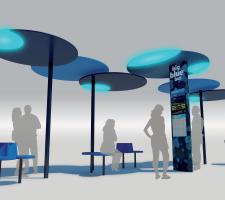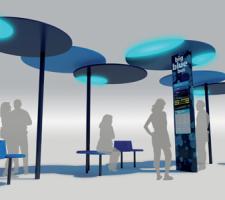
The core column at a high-/medium-level boarding stop, showing the RTI screen and location stop identification number of mobile phone (or Internet) access to information
David Crawford reports on a pioneering blend of transport technology and aesthetic
By gaining a design award before installation has even started, the US$6.9 million City ofThe virtual 'shed' - unenclosed, occupied only by minimal structures and thus open to the surrounding streetscene (the city has little rainfall through much of the year) - is the setting for an innovative alliance of ITS technology and creative design. The concept, modular component-based for location-specific assembly at individual sites, is being claimed as a first in US transit infrastructure provision.
The new-style 'blue spots' - in plan view, or on a Google map, they resemble coloured dots on the streetscape - are being installed from the first quarter of 2011. They will replace existing stops at 360 locations on Santa Monica's grid-like street layout, as well as areas outside the city that are served by its Big Blue Bus network (the city, only 21km2 in area and bounded by the Pacific Ocean to the west, is otherwise completely surrounded by Los Angeles County, the largest in the US; the Big Blue Bus service area spills out into the county).
The arrival of the Blue Spots will, the city hopes, transform perceptions of transit across the LA conurbation. The Real-Time Information (RTI) displays at major stops, instead of being conventionally hung on a stop post or the shelter frame, will be the centrepiece of strikingly designed columns, visible from streets away and creating a. series of urban landmarks promoting transit use.
Big Blue Bus project manager Dan Dawson told ITS International: "These new stops will make riding public transit a much better experience. They will offer passengers a whole new level of enhanced information and comfort."
The centrally positioned column is the key one element in the full Blue Spot kit. The others are slender steel poles topped by circular, shading disks - dubbed 'parasols' - and varying amounts of seats made out of recycled tyres.
Brand consolidation
The Blue Spots will definitively re-brand a largely ad-hoc mix of existing bus stop types. Their modular form will allow for individually tailored installation to reflect the needs of both street and intersection layouts, and the high-, medium- or low-volume passenger flows experienced, creating defined open waiting areas ranging from 1.86m2 to 18.6m2.The stops also are being graded in the level of amenity that they will offer in accordance with boarding levels (which total 75,000 a day overall across the city). High-boarding ones will enjoy RTI display screens and generous seating; all will have a stop ID and phone number to enable riders to use their mobile phones to obtain bus arrival information at any time of day or night.
Iowa, US-based
Santa Monica City Council judged that supplying electric power to the Blue Spots shelters would prove too costly and would also have run counter to its environmental targets. (Santa Monica has strongly framed 'green as possible' policies, backed by a Sustainable City Plan that the United Nations has adopted as a model for use by emerging urban areas in creating sustainable communities.)
It has therefore invested in the development of a system that can operate on solar energy from photovoltaic panels, without needing to be connected to the power grid. The energy generated will be adequate to run the RTI signs even on cloudy days, of which there are relatively few in any case in this area of California. The decision also overcame the problem of the physical constraints of Santa Monica's streets, which are of varying widths and materials, carry existing services and have limited foundation depths.
The designers are the local practice of Lorcan O'Herlihy Architects (
"Our twin inspirations," LOHA Senior Partner Donnie Schmidt told ITS International, "were Santa Monica's climatic conditions and beach culture."
The 'parasols' are a playful reflection of the beach umbrellas sprouting on the city's Pacific coastline with seats seemingly arranged informally around them.
Focus groups
Working with Santa Monica City Council, LOHA carried out a preliminary site survey of all the city's bus stops and ran focus groups for passengers, residents, businesses and city staff to develop a list of key attributes to consider in the design process. Key issues that emerged were green technology; improved safety; up-to-date and real-time information; improved cleanliness; and an enhanced street image (see Sidebar, 'Blue Spots design brief').
As part of its project development, therefore, LOHA researched and planned the location and orientation of seating at each Blue Spot stop to give the greatest possible protection from the sun during peak travel times. As a result, in contrast with conventional bus shelters, seats are rarely positioned directly underneath the overhead parasols, following careful calculation of angles. Says Schmidt: "To our knowledge, this is the first transport street furniture project in the US featuring adaptable components that respond to shade and street orientation." Another site issue arose from the fact that the city is mandated by US government legislation to offer bus stops that comply with Americans with Disabilities Act (ADA) regulations. This includes having a loading zone providing clearances for wheelchairs that can deploy without obstruction.
The sign unit closest to the street carries a target, showing where drivers are trained to bring their vehicles to a halt in order to stop to give clear access to the ADA zone. With normal street clutter having to be taken into account, the Blue Spots' minimal structure will free up space to allow a 'clear path of travel' for both disabled and non-disabled people to move more easily along the city's relatively narrow sidewalks.
Blue Spots design brief
The project is required to:
•Enhance the Santa Monica streetscape;
•Take into account the physical constraints of the city's streets;
•Allow maximum visibility for businesses and signage located around a stop;
•Feature the use of alternative energy and sustainable materials;
•Be as impervious to vandalism as possible;
•Offer easily readable and aesthetically pleasing transit information;
•Be simple and cost-effective to maintain and service;
•Adhere to 1990 Americans with Disabilities Act (ADA) regulations; and
•Allow for the most current and future transit technologiesIt will also meet concerns that were strongly expressed during the research programme by city businesses. With only four conventional shelters in the city, retailers were worried about the risk of new shelters obscuring the visibility of their storefronts and promotional signage. There were also safety concerns over pedestrians being able to see, and be seen by, oncoming traffic.
The Big Blue Bus is an agency of the City Of Santa Monica, funded by annual farebox revenues of over US$9 million and US federal, state and county subsidies. It carries 21 million passengers a year on its fleet of 210 buses, 43 per cent of which are fuelled by liquefied natural gas.
Fictionalised in the 1994 film Speed, it has won the American Transportation Association's Outstanding Achievement Award four times. It has integrated its service information into the Google Transit database, which covers other transit agencies in Los Angeles and Southern California, to enable easier multiple trip planning. Quizzed about prospects for smart ticketing, Dawson says he believes that this will follow "in the future".
Santa Monica clasims to be one of the most sustainable cities in the US. Three quarters of its public works vehicles run on alternative fuel; all its public buildings use renewable energy; and, over a 15-year period, it has cut its greenhouse gas emissions by nearly 10 per cent.
Out of the project budget of US$6.9 million for the Blue Spots programme, US$3 million has come from the US Federal Transit Administration and nearly $2.5 million from stimulus funding, a federal support mechanism to support infrastructure projects intended to create jobs and improve cities' infrastructure during the economic downturn.













